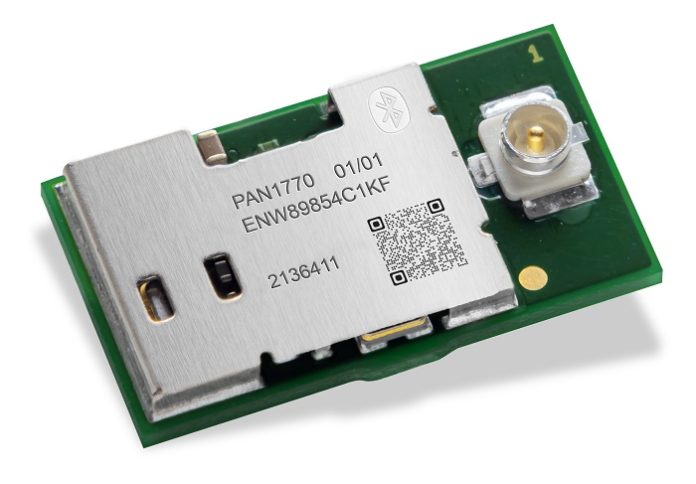Panasonic Industry is launching a new Bluetooth 5 Low Energy (LE) module that includes a uFL connector which enables the use of an external antenna. This is useful for radio-unfavourable applications where difficult housing conditions shield radio waves and an external antenna needs to be used. The PAN1770 module is based on the nRF52840 single chip controller and can be seen as a variant of the successful and proven PAN1780 Bluetooth 5 module.
Output power of up to 8 dBm plus industry-leading sensitivity of 95 dBm at 1 Mb/s and -103 dBm at 125 kb/s of the nRF52840 chip controller in combination with the LE coded PHY make the module very attractive for applications where a long range is required. In addition, ultra-low current consumption of 4.8 mA in Tx (at 0 dBm), 4.8 mA in Rx mode, 0.4 μA in System OFF mode and ~0.7 μA with RTC wake-up make the PAN1770 module an ideal choice for any battery-powered device. Featuring a Cortex M4F processor, 256 kB RAM and built-in 1 MB flash memory, the device can be used in standalone mode, eliminating the need for an external processor, reducing complexity, lowering costs and saving space. Furthermore, the PAN1770 device also supports Type 2 Near Field Communication (NFC A) for use in simplified pairing and payment solutions (external antenna required).
”We have seen that in many devices or applications, radio waves emitted by the chip antenna can be blocked or reflected by the metallic housing, making it difficult to receive the radio signal from the outside”, remarks Tomislav Tipura from Panasonic Industry Europe. “By using our new PAN1770 module, an external antenna can easily be attached via the uFL connector and thus redirect the radio waves outside the housing”, he continues.
Further technical details of the PAN1770 Module include a small footprint of only 15.6 mm x 8.7 mm x 1.8 mm, the maximum output power of 8 dBm, configurable from -20 dBm in 4 dB steps and -40 dBm in whisper mode, 802.15.4 support: Matter & Zigbee & Thread, as well as up to 48 programmable GPIOs along with a rich Hardware Interface, set: SPI, I2C, UART, PWM, ADC, NFC, USB2.0.

